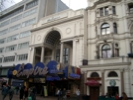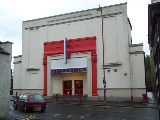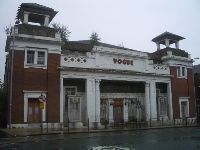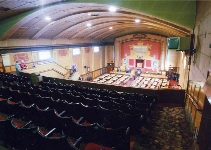The Search for Style: Cinemas of the 1920s [Part 1]
While the British had been fighting the First World War, the Americans
had been perfecting the art of making movies. Hollywood now had the
biggest stars, the most exciting stories and seemingly limitless
finance and expertise. To show off their latest epics, the major
studios built chains of luxury cinemas throughout America and beyond.
Metro-Goldwyn-Mayer, then considered the most glamorous studio, was
able to boast ‘
More Stars Than Are In The Universe’ and
proved its status with palatial architecture. B. Marcus Priteca, a
Glaswegian who emigrated to the United States, designed some of its
most innovative West Coast movie theatres – such as the San
Francisco Pantages (1911) and the Seattle Coliseum (1916). Priteca went
on to design a series of opulent theatres for the Pantages circuit,
culminating with the stunning Hollywood Pantages (1930).
| Thomas Lamb,
another Scots émigré from Dundee, became MGM’s
chief architect, producing well over a hundred movie palaces, usually
in flamboyant French baroque style, all over the USA. In London, he
designed MGM’s showcase Empire in Leicester
Square, which opened in November 1928 on the site of an old music hall.
Not surprisingly, British architects who became involved in cinema
design in the latter 1920s copied American precedents. Some architects
even visited there to study the latest examples. |
 |
In Scotland, John
Fairweather was to design the largest new picture palaces – each
one obviously influenced by American practice. After his earlier visits
to New York, McKissack would have been very aware of the kind of
glamorous imagery associated with the Hollywood scene, skyscrapers and
ocean liners (some of which were, after all, built on the Clyde).
During the war, the cinema had become well established as a favourite
entertainment for many urban Scots. Thus, cinema buildings, both
entirely new and converted from existing premises, were established
throughout the country. No cinemas were built during the war as
materials and effort were expended on achieving victory, rather than on
satisfying the increasing market for entertainment – indeed all
so-called ‘luxury buildings’ were banned until 1921.
The First World War proved difficult for the cinema and many existing
cinemas were forced to close. A shortage of staff and musicians (due to
conscription) and similarly a short supply of new films (due to the
Atlantic Blockade) are obvious reasons. A third was the introduction of
an Amusement Tax in May 1916 – no doubt to raise
money for the War Effort – meant that cheaper tickets
disappeared.
 |
Even so, McKissack did design The Picture House in
Cowdenbeath, which was completed in 1919; probably because coal was
vital to the success of the war effort and thus construction of
entertainment facilities for miners’ welfare may have been
acceptable in that context. Cowdenbeath was, of course, at the heart of
the Fife Coal Field.
Not surprisingly, this cinema was something of an
‘austerity’ design, it being a rather pedestrian hall of
brick over steel frames, clad externally in harling and with rusticated
cement stucco on its façade. |
Within, it had a balcony with the
small entrance hall below, whilst the auditorium was largely unadorned,
except for the proscenium arch which had egg and dart mouldings, and
fibrous pilasters on the sidewalls, expressing the positioning of the
main structural members. The ceiling was barrel-vaulted, being
formed of plasterboard attached to the inside of the roof trusses
– common practice in cinema outfitting at that time.
|
La Scala in Hamilton, which opened in 1921, was rather more
invigorating than The Picture House in Cowdenbeath. Indeed, in some
ways, it looked back to Edwardian design practice, albeit on a more
substantial scale. Its façade, for instance, was capped on
either side by bell towers, similar to those on the pre-war Silver
Cinema in Edinburgh. Furthermore, the entrance doors were flanked by
cast iron columns identical to the ones found at La Scala in Glasgow.
Otherwise, the entrance portico was finished in blocks of moulded white
faience – ideal in grimy industrial conditions - and the
remainder of the steel-framed structure was clad in red facing brick.
It looked prosperous and even had a certain civic dignity. |
 |
 |
The interior of this cinema reflected the long and relatively narrow
fue upon which it was built. It only had a very shallow entrance
hall with stairs on either side to the balcony. This faced the screen
squarely (there was no need for a curve to improve the sightlines due
to the great depth of the auditorium relative to its
width).
Decoratively, it was largely unadorned, save for pilasters on
the sidewalls and other details similar to Cowdenbeath. Once again,
expenditure was focused on the proscenium arch and this one had a
plaster cartouche, surrounded by scrolls and foliage.
|
Thereafter, cinema building again slumped for a few years. One probable
cause was the increasing popularity of another new entertainment
– radio - which reduced cinema attendance. Nevertheless, a number
of existing cinemas in prominent locations were very successful and
some were enlarged to maximise their potential.